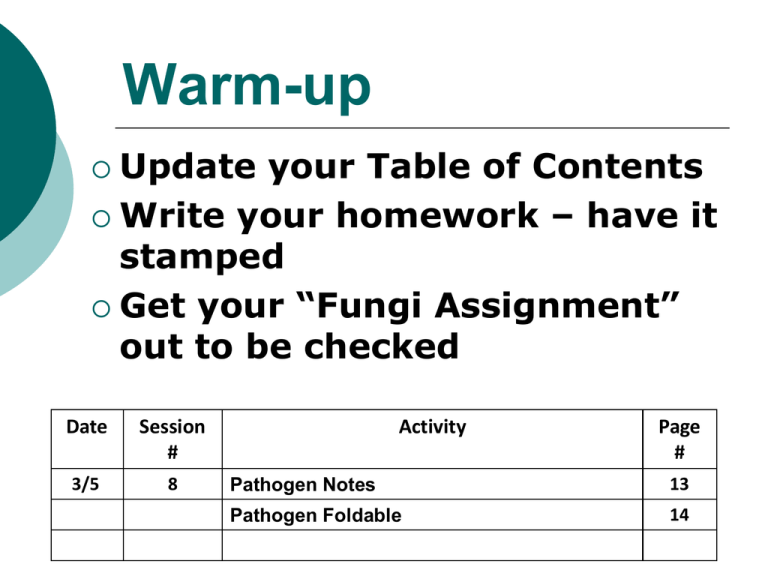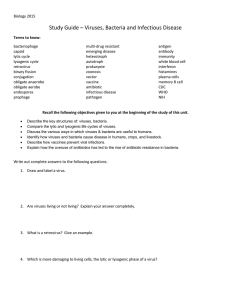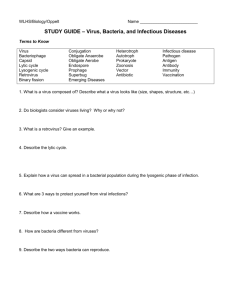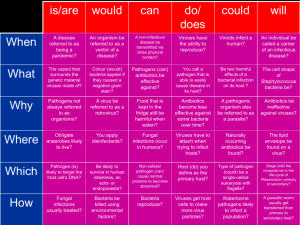Warm Up
advertisement

Warm-up Update your Table of Contents Write your homework – have it stamped Get your “Fungi Assignment” out to be checked Date Session # 3/5 8 Activity Page # Pathogen Notes 13 Pathogen Foldable 14 Homework Research any disease and find out the following: What type of pathogen it is caused by What the symptoms are How can it be treated Any other info about it/picture Find out what you have received vaccinations for Pathogens Cause Disease We will focus on 4 Types of Pathogens: Fungi Bacteria Viruses Parasites Fungi Fact Review What would you ask about Fungi on a quiz? ERT = Everybody Reads To… 1) 2) 3) We will read one paragraph at a time Discuss the answers to the questions Then take notes in the box ERT PARAGRAPH 1 Pathogens Pathogen - Anything that can cause disease or harm Also referred to as microbes or germs Virus, Bacteria & Parasites are the 3 main types of disease spreading pathogens Types of Diseases • Non-communicable: Cannot be passed from person to person – Can be due to genetics, lifestyle choices, or environmental factors – EX: Cancer, ALS, Alzheimer’s, Arthritis, Heart Disease, Diabetes Communicable (Infectious or Contagious): – Caused by a Microbe entering body and reproducing – Bacteria, Virus, Parasite – Easily spread between individual organisms – EX:Cold, Flu, Strep Throat – • ERT PARAGRAPH 2 Virus NOT LIVING – Needs a host to survive and reproduce Since it is not alive, it has NO CELLS Very small Vaccines used to treat How a Virus Attacks a Cell… http://www.youtube.com/watch?v= Rpj0emEGShQ ERT PARAGRAPH 3 Bacteria Living organisms Unicellular, prokaryotic Larger than viruses, but usually more treatable Antibiotics used to treat Fun Fact:Clean skin has about 20 million bacteria per square inch… ERT PARAGRAPH 4 Parasites Living organisms that need a host to survive – highly adapted to their host Unicellular or multicellular Come in many shapes and sizes Maggots in My Head http://www.youtube.com/watch?v=V2 Ac6RYSvo8 Tapeworm in My Eye http://www.youtube.com/watch?v=jVb rXbmPHpo Pathogen Foldable Quickly create a foldable that contains quick reference information for each type of pathogen USE YOUR PATHOGENS FOLDABLE TO ANSWER THE FOLLOWING ON PAGE 14: How are viruses and bacteria different? How are parasites and viruses similar? Which type of pathogen would you consider most serious and why? Warm-up Update your Table of Contents Write your homework – have it stamped Tape your disease research to the wall around the room – MAKE SURE YOUR NAME IS ON IT! Make sure you have answered the questions on page 14 using your pathogens foldable from last class Date Session # 3/7 9 Activity Spread of Disease Note Guide Page # 15 What Was A Pathogen Again…? Pathogens are anything that cause disease…they are also referred to as microbes and germs What Were the 4 Pathogens We Are Focusing On Again…? Fungi Bacteria Viruses Parasites Throw Up…I Mean Warm Up Turn to page 14 and make sure your have answered the following using your pathogens foldable: How are viruses and bacteria different? How are parasites and viruses similar? Which type of pathogen would you consider most serious and why? Pathogen Gallery Walk Which disease did you research? Tape your research up around the room so we can review all of the diseases that were researched! What vaccinations have you received? Who Figures All of This Out? An Epidemiologist is a scientist who studies diseases including how they start, spread and how they are treated. Spreading Disease… How does it happen…LET’S INVESTIGATE!? Finding Patient Zero Each person will receive a test tube and a syringe You will carefully go around the room and trade fluids with 2 other people using the syringe Remember who you trade with and in what order When completed, sit down and write down who you traded with first and second Contagions Many pathogens are also said to be contagions Contagions – capable of being spread by direct or indirect contact (in other words…contagious) Contagion Clip http://www.youtube.com/watch?v= Z7yL5DFbK5A Features Kate Winslet as an epidemiologist trying to trace back to “patient zero” How Do Pathogens Cause Harm? They can change what your cells do Especially viruses and even chemicals Mutagen – something that actually changes or “mutates” the genetic material of an organism How do pathogens spread? 4 main ways that pathogens are transferred: Person to person Food and water Environment Animals People to People… Carrier – a person who is infected and can infect others but may not show the symptoms of the disease themselves Types of Carriers 1. Symptomatic: – they show symptoms of the disease; they are SICK – they are actively spreading disease particles to others while they are sick – May be coughing, sneezing, have runny nose – EX: Influenza, Chicken Pox, Common Cold 2. Asymptomatic: – Does not appear to be sick – Can still actively spread disease to others – EX: HIV Food and Water Contaminated food and water can spread pathogens, below are a few examples: = - Infected animals - Food or water that comes from unsanitary areas or isn’t cleaned - Eating raw or undercooked food Environments Moist Average temperatures More ability to reproduce Sunlight Not too hot or too cold Limited exposure to fresh air A lot like water Good for some, bad for others Food sources Sugars or decaying material Animals • Vector – Insects and animals that spread disease to humans EXAMPLES: – – – Fleas – transmit bubonic plague Ticks – transmit Lyme disease Mosquitoes – transmit Malaria Medicine Antibiotics – Medicine that prevents the growth and reproduction of bacteria Vaccines – A weak dose of a virus that helps your immune system kill the real virus later Preventing the Spread… Eat right, get enough rest, avoid stress Antibacterial soaps and antimicrobial solutions (don’t overuse) Antibiotics (don’t overuse) Get vaccinated Covering our mouths when we cough or sneeze Avoid unnecessary contact with people, animals or objects that could be contaminated! Keep studying diseases and how they adapt and change! Questions?? Warning…Outbreak! Create a warning poster, warning sign, comic, commercial jingle or brochure or any other format you can think of warning your neighborhood about a possible disease outbreak! Things to include: Name: disease (real or fictional) Mugshot: picture Description of suspect: virus, bacteria, parasite? Crimes: how does it attack? how does it spread? symptoms? common victims? How can you prevent being infected? Reward??? Must be informational, but can also be silly!! Examples Warm-up Update your Table of Contents Write your homework – have it stamped Put your Warning…Outbreak! assignment in the basket Date Session # 3/11 10 Activity Page # 16 Recap Antibiotics treat what type of pathogen? Vaccines? Why do we not want to overuse antibiotics, antibacterial cleaners or antimicrobial solutions? Describe the job of an epidemiologist. Why do you think that diseases that are no longer an issue in the United States are still a problem in other parts of the world? Mythbusters: Flu Fiction How Easily Can Pathogens Really Spread?







